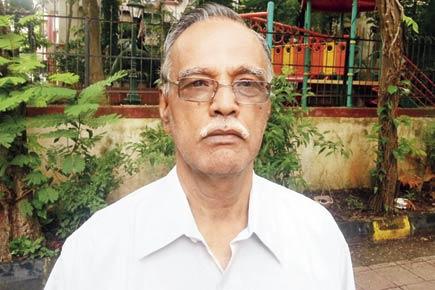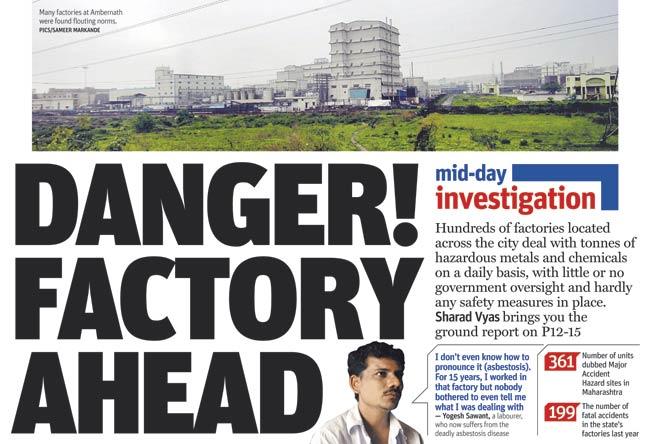Following the July 21 mid-day story on the dangers posed by chemical plants in and around Mumbai, a former in-charge of the chemical department of a factory in Chembur, recounts his 35 years in the industry

On a morning in July 1986, S S Narayanan noticed hundreds of pigeons lying dead in his factory compound in Chembur. As a process operator at the chemical plant, he immediately knew that the birds had most probably died due to the inhalation of deadly gases released from the overnight distilling of naphtha at the unit.

S S Narayanan’s account portents a disaster waiting to happen
ADVERTISEMENT
When he brought the issue to the notice of the management of Union Carbide India Limited (UCIL), which was accused of showing apathy following the disaster at the company’s plant in Bhopal just two years before this, they decided to hush up the matter.
The UCIL had set up the plants in Chembur and Bhopal, along with three others across India, in 1970, and the Chembur factory had functioned for nine years without any maintenance. The factory shut around 2010.

mid-day story on the dangers posed by chemical plants
Following the July 21 mid-day story on the dangers posed by chemical plants in and around Mumbai (‘Mumbai’s Ticking Time Bombs’), Narayanan, the former in-charge of the chemical department at the UCIL factory in Chembur, recounts his 35 years in the chemical industry.
Retired in 2005, Narayanan’s stories of neglect and extortion by inspectors of the Directorate of Industrial Safety and Health (DISH) and the apathy shown by factory managements towards the safety of workers and the public at large, portent a disaster waiting to happen. Here’s his account:
As a person who has worked in the chemical industry for 35 years, I can tell you that that the one thing that has not changed over the years is factory owners’ neglect towards ‘cheap’ labour and hazardous chemicals. Even now, when I tour chemical plants as a consultant, I can see barely any change in the attitude of putting health and safety on the backburner.
Even in big factories, you will find that safety regulations are bypassed or compromised. Several years ago, textile workers were found to be suffering from byssinosis (a lung disease caused by inhalation of cotton particles in ginning departments) and mill owners denied that the workers’ illness was due to occupation hazards.
It took several years of research to prove the connection between the nature of work in the mill and the sickness. Mill owners would try to hush up the matter and only after a long struggle was this sickness included in the Workmen’s Compensation Act. The compensation, however, is a pittance.
The reasons for the suffering of workers are very simple. During my long years of service in a chemical factory, where acetylene, ethylene, propylene, benzene, crotonaldehyde etc were manufactured, I rarely saw any factory inspector entering the premises. I’m sure you can guess the reasons for that.
The company used to send employees, who developed employment-related sicknesses, to its own doctors, who would always give a report favouring the employer. The factory where I used to work had high noise pollution, high temperatures, corrosive chemicals and even carcinogenic ones, but the employees were never sent for periodic medical check-ups.
In the few cases that the check-ups happened, company doctors would never report about any employee suffering from any employment-related sickness. The factory was never modernised because the employers always felt spending money on modernisation was a waste of money.
For them, the lives of employees were very cheap. In the factory where I used to work, several crores used to be shown as spent in the name of modernisation, but nothing changed on the ground. It was used as an excuse to fudge accounts but none of this ever came out because even the auditors did not bother to find out what that truth was.
This is happening in all industries and the DISH exists mostly only on paper since its inspectors rarely visit factories and even if they do, the owners usually get to know in advance and take them on a round of selected areas on the premises. In fact, in my factory, some of the units which caused heavy pollution used to be shut down during such rare visits. The reason for the lackadaisical attitude of the factory owners is this thought process: Why spend money on safety, human lives are cheap. Even after the Bhopal tragedy, our country has not learnt a lesson since factory inspectors turn a blind eye to violations for obvious reasons.
Hazards galore
According to Narayanan, till 1966, ethylene for manufacture of polyethylene used to be made from a chemical reaction of ethyl alcohol and sulphuric acid. The ethylene thus made had to be polymerised in a high-pressure reactor under a pressure of 30,000 psi for making polyethylene. Only two companies, UCIL and ICI (Calcutta), were into this business.
In 1966, for the first time in India, UCIL started cracking of naphtha for getting various by-products, including hydrogen, ethane, methane, ethylene, propylene, propane, acetylene and benzene. The process was complicated: Naphtha used to be cracked at 850 degrees Celsius and the products had to be brought to room temperature in stages.
Thereafter, the solution had to be compressed to approximately 40 kgs/cm square, in stages, so as to reduce the volume of the cracked gas. This compressed gas had to be sent to distillation columns at low temperatures to separate the various fractions of naphtha. Each constituent had a different boiling point and various fractions were distilled/separated using this chemical property.
All the chemicals were very hazardous. Handling acetylene needs a lot of skill, while benzene is highly carcinogenic. Apart from hot burns, cold burns (which take place as a result of the skin coming in contact with an object that is extremely cold) were also a hazard. Also, high noise pollution (more than 12 decibel) is very prevalent in such industries.
The other side
A K Srivastava, legal assistant to Union Carbide and Eveready Industries India Ltd (EIIL), which took over UCIL in toto in 2002, said the plant in Chembur was sold to another group in the late 1990s, and it would be difficult to ascertain facts at this point.
“It will be very difficult to say what went wrong inside the plant or what kind of guidelines were being ignored as is being alleged by a former employee. But I know for a fact that it was one of the better managed plants of all the UCIL units in India during the time,” he told mid-day over the phone from Bhopal.
1970
The year in which Union Carbide India Limited had set up its plants in Chembur and Bhopal
 Subscribe today by clicking the link and stay updated with the latest news!" Click here!
Subscribe today by clicking the link and stay updated with the latest news!" Click here!







